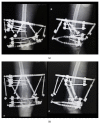Intra- and Extra-Articular Deformity of Lower Limb: Tibial Condylar Valgus Osteotomy (TCVO) and Distal Tibial Oblique Osteotomy (DTOO) for Reconstruction of Joint Congruency
- PMID: 30906598
- PMCID: PMC6398061
- DOI: 10.1155/2019/8605674
Intra- and Extra-Articular Deformity of Lower Limb: Tibial Condylar Valgus Osteotomy (TCVO) and Distal Tibial Oblique Osteotomy (DTOO) for Reconstruction of Joint Congruency
Abstract
Osteotomies are the established surgical procedure for the deformity of the lower limb induced by osteoarthritis (OA) of the knee and ankle. Closed-wedge (CW) and open-wedge (OW) high tibial osteotomy (HTO) are extra-articular surgery, which aim to shift the mechanical axis from medial to slightly lateral and reduce the overload in the medial compartment of the varus deformed knee by extra-articular correction. However, varus deformity of the knee with the teeter effect, which could be accompanied with subluxation and thrust due to the medial-lateral soft tissue imbalance, is not resolved only by the shift of mechanical axis. The depression of the medial tibia plateau, so-called pagoda deformity, is the intra-articular deformity, which could potentially cause the teeter effect and involves intra-articular incongruency. In such case, the osteotomy with novel concept should be developed to overcome the issues, both the imbalance of soft tissue and intra-articular deformity. Tibial condylar valgus osteotomy (TCVO) is an intra-articular osteotomy, which improves the joint congruency of the medial-compartment knee OA with subluxation and/or intra-articular deformity and also provides better joint stability. A similar argument is raised in the treatment of the ankle OA. Low tibial osteotomy (LTO) is an extra-articular surgery to correct malalignment of lower leg. Distal tibial oblique osteotomy (DTOO) is a novel surgery to improve the bony congruency of the ankle OA. In DTOO, the distal tibia is cut obliquely from the proximal medial to the distal lateral in the coronal plane and towards the center of the tibiofibular joint to improve the bony congruency of the ankle joint. Tibial condylar valgus osteotomy (TCVO) and distal tibial oblique osteotomy (DTOO) can correct intra-articular deformity of knee and ankle, respectively. The rationale and indication of TCVO and DTOO for the treatment of the lower limb by reconstructing the joint congruency are discussed.
Figures










Similar articles
-
Salvage of severe knee osteoarthritis: efficacy of tibial condylar valgus osteotomy versus open wedge high tibial osteotomy.J Orthop Surg Res. 2021 Jul 14;16(1):451. doi: 10.1186/s13018-021-02597-x. J Orthop Surg Res. 2021. PMID: 34261504 Free PMC article.
-
Tibial condylar valgus osteotomy for the treatment of intra-articular varus deformity of the knee.Ann Jt. 2022 Oct 15;7:37. doi: 10.21037/aoj-22-19. eCollection 2022. Ann Jt. 2022. PMID: 38529161 Free PMC article. Review.
-
The Teramoto distal tibial oblique osteotomy (DTOO): surgical technique and applicability for ankle osteoarthritis with varus deformity.Strategies Trauma Limb Reconstr. 2018 Apr;13(1):43-49. doi: 10.1007/s11751-018-0307-0. Epub 2018 Jan 29. Strategies Trauma Limb Reconstr. 2018. PMID: 29380255 Free PMC article.
-
Tibial Condylar Valgus Osteotomy Combined With Medial Open-Wedge Distal Tuberosity Tibial Osteotomy.Arthrosc Tech. 2022 Mar 16;11(4):e569-e575. doi: 10.1016/j.eats.2021.12.009. eCollection 2022 Apr. Arthrosc Tech. 2022. PMID: 35493060 Free PMC article.
-
Tibial condylar valgus osteotomy - indications and technique.J Exp Orthop. 2020 May 13;7(1):30. doi: 10.1186/s40634-020-00247-5. J Exp Orthop. 2020. PMID: 32405777 Free PMC article. Review.
Cited by
-
Distal tibial oblique osteotomy for reconstruction of ankle joint congruity and stability.J Clin Orthop Trauma. 2021 Sep 4;22:101588. doi: 10.1016/j.jcot.2021.101588. eCollection 2021 Nov. J Clin Orthop Trauma. 2021. PMID: 34527512 Free PMC article.
-
Bone marrow lesion severity was associated with proximal tibial inclination in early knee osteoarthritis.Knee Surg Sports Traumatol Arthrosc. 2022 Feb;30(2):668-679. doi: 10.1007/s00167-020-06378-7. Epub 2021 Jan 4. Knee Surg Sports Traumatol Arthrosc. 2022. PMID: 33394079
-
Finite Element Analysis of Protective Measures against Lateral Hinge Fractures in High-Tibial Osteotomy.Adv Orthop. 2024 Aug 22;2024:5510319. doi: 10.1155/2024/5510319. eCollection 2024. Adv Orthop. 2024. PMID: 39220812 Free PMC article.
-
Geometrical analysis of the opening gap after tibial condylar valgus osteotomy for proper hinge point selection.Ann Transl Med. 2022 Dec;10(23):1267. doi: 10.21037/atm-22-2022. Ann Transl Med. 2022. PMID: 36618801 Free PMC article.
-
Anterior Proximal-to-Posterior Distal Oblique Proximal Tibial Osteotomy.Arthrosc Tech. 2021 Oct 6;10(11):e2421-e2427. doi: 10.1016/j.eats.2021.07.018. eCollection 2021 Nov. Arthrosc Tech. 2021. PMID: 34868843 Free PMC article.
References
-
- Siman H., Kamath A. F., Carrillo N., Harmsen W. S., Pagnano M. W., Sierra R. J. Unicompartmental knee arthroplasty vs total knee arthroplasty for medial compartment arthritis in patients older than 75 years: comparable reoperation, revision, and complication rates. The Journal of Arthroplasty. 2017;32(6):1792–1797. doi: 10.1016/j.arth.2017.01.020. - DOI - PubMed
-
- Duivenvoorden T., Brouwer R. W., Baan A., et al. Comparison of closing-wedge and opening-wedge high tibial osteotomy for medial compartment osteoarthritis of the knee: a randomized controlled trial with a six-year follow-up. The Journal of Bone & Joint Surgery—American Volume. 2014;96(17):1425–1432. doi: 10.2106/jbjs.m.00786. - DOI - PubMed
Publication types
LinkOut - more resources
Full Text Sources

